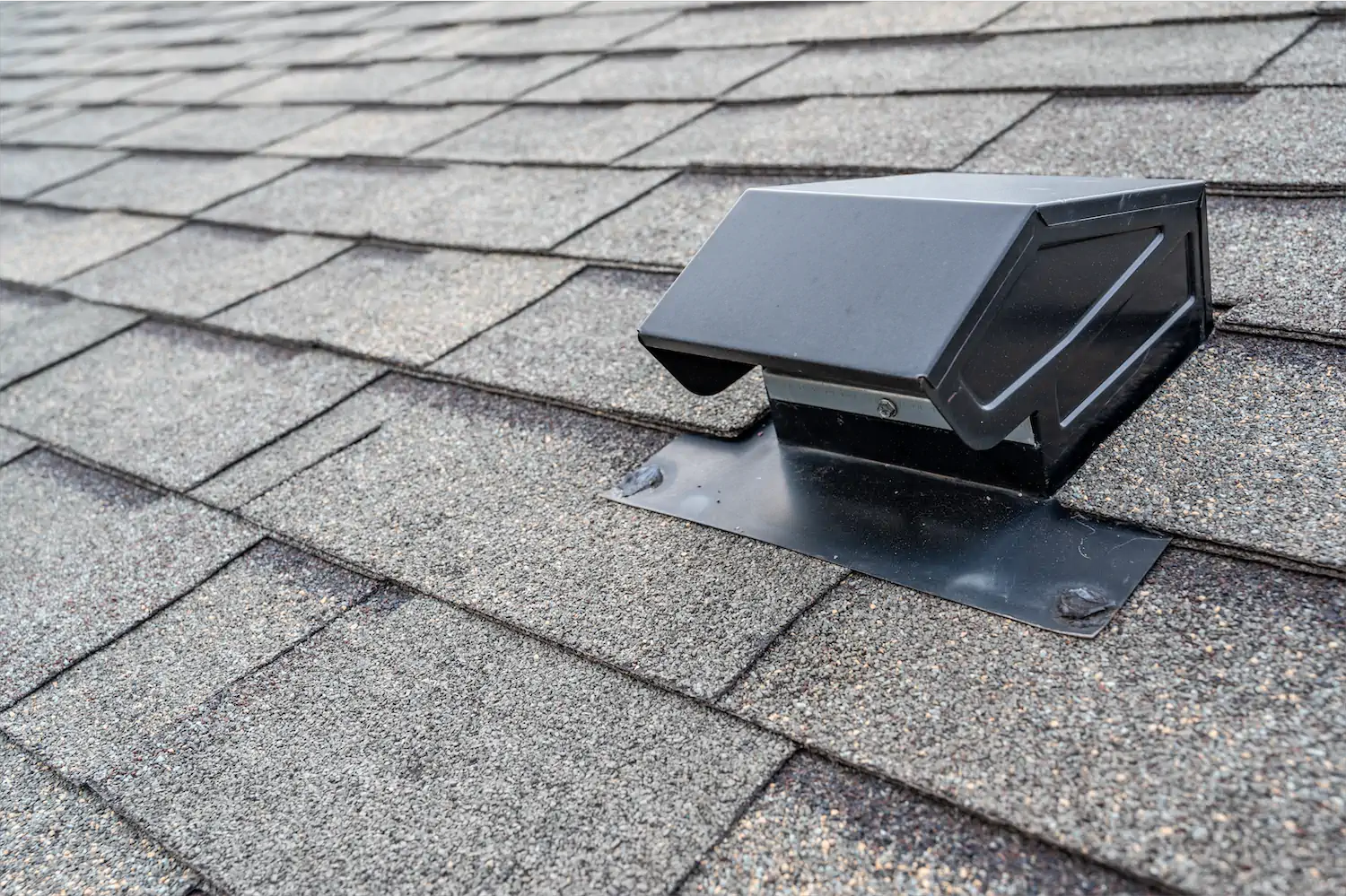The roof is one of the most important parts of your home, and it’s essential to ensure that it is well-maintained and properly ventilated. Many homeowners overlook the importance of roof ventilation, but it can have a significant impact on the longevity of your roof and the overall health of your home. In this article, we’ll discuss the importance of roof ventilation and how to determine if your home needs it.
What is Roof or Attic Ventilation?
Roof ventilation is the process of allowing air to circulate through the roof space. This is typically achieved through the installation of roof vents or fans, which allow hot air to escape from the attic or roof space, while cooler air is drawn in from outside. Proper roof or attic ventilation is essential to prevent damage to your roof, reduce energy costs, help the attic cool, and improve the overall comfort of your home.
Why is Roof Ventilation Important for Homeowners?
Roof ventilation has several important benefits, including:
- Preventing moisture buildup: Proper ventilation helps prevent moisture buildup in the attic or roof space, which can lead to mold, mildew, and rot.
- Extending the life of your roof: Excessive heat and moisture can cause roof shingles to deteriorate prematurely, leading to the need for costly repairs or replacement.
- Reducing energy costs: Proper ventilation can help regulate the temperature in your attic, reducing the load on your air conditioning system and lowering your energy bills.
- Improving indoor air quality: Proper ventilation can help reduce indoor air pollutants, such as mold spores and allergens, which can lead to respiratory problems.
Common Types of Roof Vents Available for Homes?
The plan for roof vents at your home will vary depending on a variety of factors. And, because each home is unique, the plan for providing proper ventilation for your home should be equally unique and customized specifically for your roof. Not every type of vent is right for just any type of home. Each type of roof vent has pro and cons. The goal of this section is to provide a summary of the various types of vents that we suggest and set up for residential properties.
Wind Turbine Vents
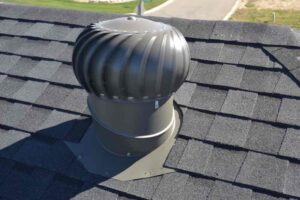
This type of roof vent is commonly seen on homes and often referred to as “whirlybirds” due to their spinning motion powered by wind. They effectively remove hot air and moisture from attics.
Whirlybird roof wind turbines aren’t the most effective roof vent, but there are a lot of benefits to using them. First, they are eco-friendly and green because they do not require electricity. With the exception of occasionally lubing of the unit, there is little to no maintenance or upkeep required. And unlike the power vents we mention next, they are quite silent even on a windy days where gusts exceed 20 miles per hour.
Powered Roof Attic Vents
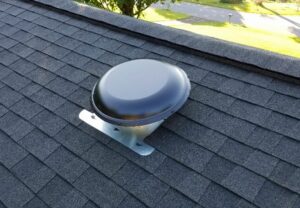
Powered attic vents, also known as powered attic ventilators or attic power vents, are electric-propelled fans that help pull stale air out of an attic space. They work much like a box fan placed in a window on a hot summer day. They can effectively pull the hot air out, but come with a tradeoff of higher electricity costs.
Attic vents contain motors and fans that are designed to remove heat and moisture. Certain models are equipped with thermostats and humidistats that allow you to regulate the temperature and humidity levels. These vents can be programmed to activate when levels surpass a specific threshold.
Box Roof Vents
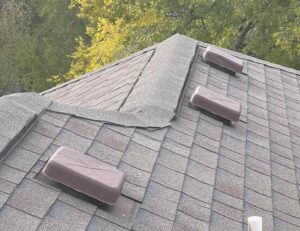
Box vents are a much more popular venting solution for your roof. They are one of the two most popular exhaust vents you’ll see on a modern-day roof. Their small smaller size offers some versatility. And, because they don’t need to run across the entire peak of the roof, box vents can be installed strategically in smaller areas that need the flow of air to be vented but cannot utilize a ridge vent.
Like with off-ridge vents, using a box vent makes sense for more complicated roof lines that have lots of different sections. But if you have a larger roof line, then a ridge vent is most often much more effective. However, off-ridge vents are very commonly used on hipped roofs and if you have a hip roof, then these are a great option.
Ridge Vents
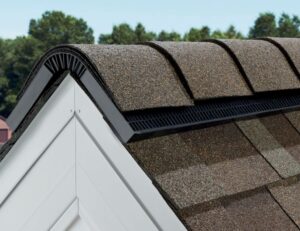
A ridge vent sits at the peak of your roof and runs across the entire span of your roof line. Because ridge vents are located at the roof’s highest point, they are in prime position to let the hottest air escape the attic space. And because they run across the entire roof line, they generally have the surface area necessary for expelling large amounts of hot air.
The design of a ridge vent, its location on the roof line, the surface area covered, as well as cost and commonality are just a few of many reasons that this is one of the most popular exhaust vents out there, and one that we highly recommend if it fits your home’s architecture.
Off Ridge Vents
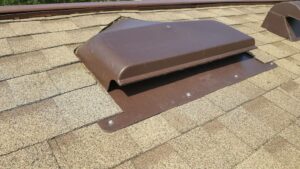
Off Ridge vents are installed along the highest point of the roof and work by allowing hot air to escape from the attic space. This type of vent is particularly effective in climates that experience extreme heat during the summer months, as it helps to keep indoor temperatures cooler and reduce energy costs. Additionally, off ridge vents can help prevent moisture
If your home has lots of peaks, valleys, and dormers, then this may be a type of vent to include in your ventilation system. This will not always be the case however, so make sure you speak with a trustworthy roofer before making the call.
Soffit Vents
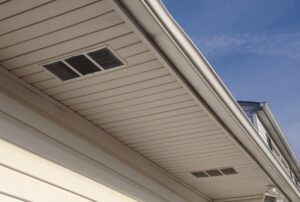
Soffit vents are installed in the soffits, or the underside of eaves, to allow air to flow through the attic and provide proper ventilation for your entire roof system. Properly functioning soffit vents can help reduce energy costs by decreasing the temperature in the attic and reducing the amount of moisture that collects.
Gable Vents
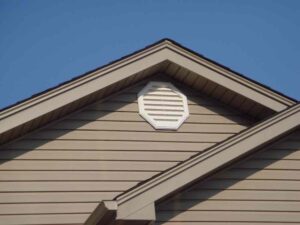
Gable vents are one of the most commonly used roof ventilation systems, and for good reason. They’re highly efficient at providing your home with the necessary air flow to combat attic moisture, heat buildup, and condensation. These vents are typically placed on either side of a gable roof—the triangular section at the end of the roof line—and they consist of two pieces.
Solar-Powered Vents
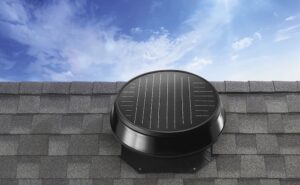
Solar powered attic vents provide air circulation and prevent heat buildup, while also helping your reduce energy bills because they draw in cooler air from outside. They do this through the use of photovoltaic cells that capture sunlight and convert it into electrical energy, which is then used to power the vent.
Signs That Your Home May Have A Roof Ventilation Problem.
There are several signs that may suggest poor ventilation and that your home may need roof vents to aid in proper ventilation. Here’s are some of the most commons signs to watch for.
Excessive heat in the attic.
If your attic feels excessively hot, this may indicate that hot air is trapped and not being properly ventilated.
Proper roof ventilation helps to regulate the temperature in the attic and protect the home from potential damage such as excessive moisture and trapped heat. Without proper ventilation, warm air can build up in the attic, leading to a number of issues.
Excess Moisture buildup.
If you notice signs of moisture buildup, such as water stains or mold growth, this may indicate that your roof is not properly ventilated.
Proper roof ventilation prevents moisture build-up and damage to the roof structure, as well as promoting energy efficiency. Moisture buildup in the attic can cause rot, mold, mildew, and other problems down the line.
If you notice signs of moisture buildup, you should definitely give us a call or schedule a free onsite consultation. We are a licensed roofing contractor and we’ll be able to help you understand your roof repair options.
Ice dams.
If you live in a cold climate and experience ice dams on your roof, this may indicate that your attic is not properly ventilated.
Ice dams can cause serious damage to your home, including water damage and rot. When warm air rises up through the attic into the roofing material, it can cause snow and ice on the eaves of the roof to melt and refreeze at the edges of the roof
However, when the roof is properly vented, that same warm air on the inside of your home will rise up through the attic and out of the roofing material. This helps keep snow and ice from melting on the eaves of the roof and prevents the refreezing at edges of the roof that are so problematic.
Poor Roof Ventilation Means High energy bills.
If your energy bills are higher than usual, this may indicate that your attic is not properly ventilated, and your air conditioning system is working harder than it needs to. However, proper ventilation helps to reduce energy costs by allowing hot air to escape during the summer months, and cold air to enter during winter months.
Conclusion
Roof ventilation is an essential aspect of maintaining a healthy and long-lasting roof. Proper ventilation helps regulate the temperature of your attic and reduce humidity levels, which can cause mold growth, moisture damage, and other severe issues. So, if you notice any signs of moisture buildup, excessive heat, or higher than normal energy bills, allow one of our licensed roofers to determine if your home needs roof ventilation. Properly ventilating your roof, you can prevent costly repairs, improve indoor air quality, and increase the overall comfort of your home.
